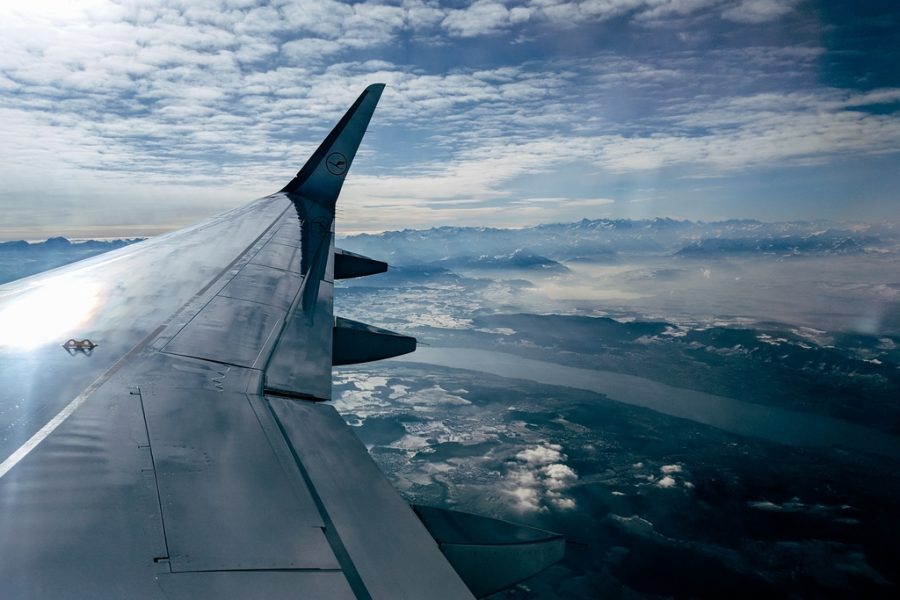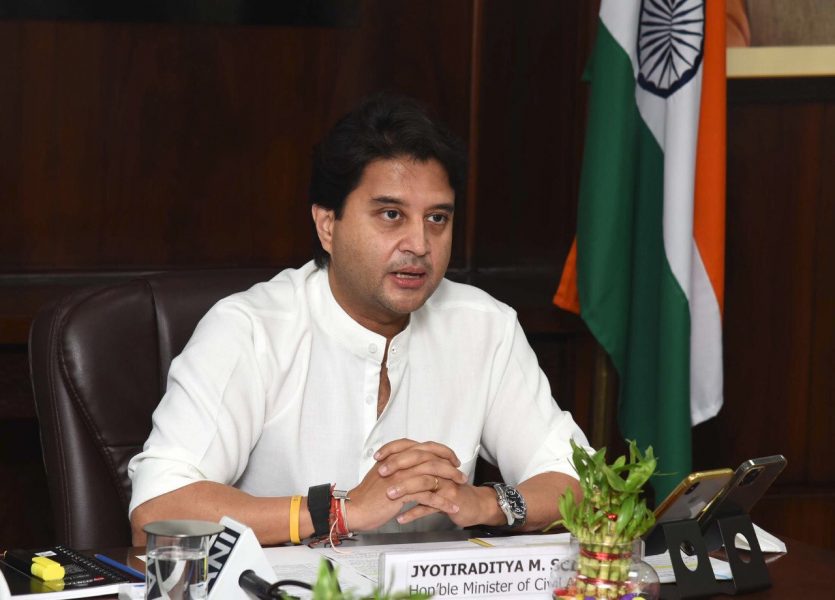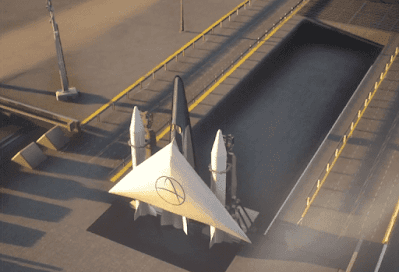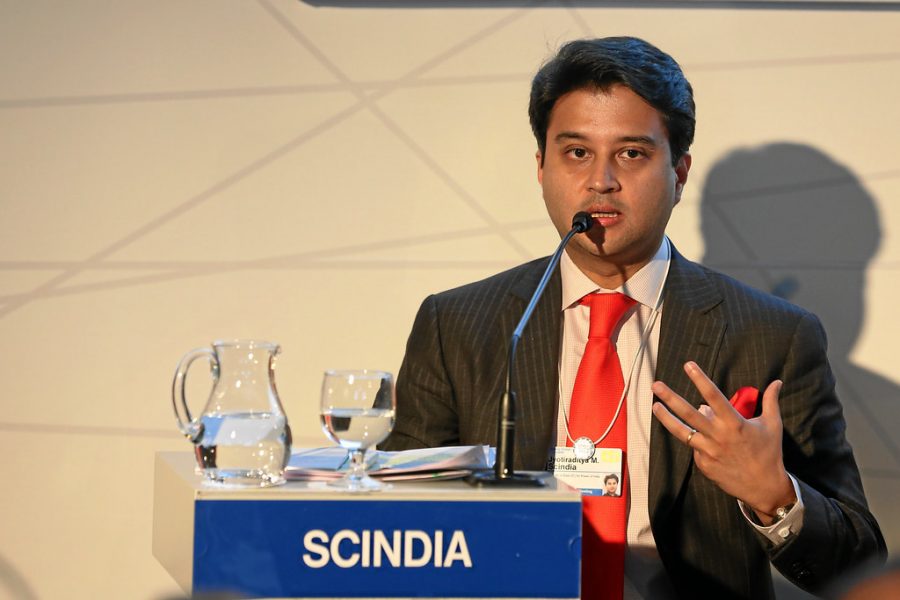C02-neutral flying | Here's how you can now offset CO2 emissions directly on-board
Prashant-prabhakar
07 Feb 2022

In what can be termed as a first of its kind, Lufthansa airlines is now testing a new service that would allow passengers to offset the carbon emissions of their air travel directly onboard. This service, with Internet connectivity, is to be available to all Lufthansa passengers flying to and from Munich on all short- and medium-haul flights.
Representative | Dezeen
How does it work?
Passengers can now choose how to offset the CO2 emissions of their flight via a range of options available through the onboard entertainment system.
The service can be accessed free of charge via the internet available onboard. Using a slider, passengers can navigate to one of three options available for offsetting, namely :
Sustainable Aviation Fuel made from biogenic residueHigh-quality carbon offset projects run by the non-profit organization myclimateCombination of both
Apparently, this new service incorporates the technology of the "Compensaid" platform for CO2-neutral air travel developed by the Lufthansa Innovation Hub in 2019.
Compensaid - Lufthansa Innovation Hub
Compensaid is Lufthansa Group's digital platform for CO2-neutral flying. Having been tested as a prototype in 2019, integrated into the booking process of the various Lufthansa Group airlines and is also available as an offer for Lufthansa Group's corporate customers via the Compensaid Corporate Program.
Lufthansa Group
Lufthansa Cargo also offers a CO2-neutral freight product based on Compensaid technology.
The digital platform was developed in cooperation with the Lufthansa Group's fuel experts, who purchase the certified fuel globally and feed it into Lufthansa flight operations.
Lufthansa Group
Additionally, the company also has another venture by the name "Squake"- which also offers a CO2 compensation platform enabling travel and transport companies to choose sustainability initiatives from a bank from partners and projects.
The business-to-business platform calculates CO2 emissions of trips and offers ways for them to be offset within the booking process.
The platform is free for sustainability businesses to sign up to and Squake charges a 10% fee on every transaction made by the customers of the travel businesses using it.
We’re really trying to decarbonise everyone in the entire supply and travel chain and that’s a really grand vision which is why I’m excited about it. When you dial it down a little bit, it’s really about building the green backbone for each company in that segmentChristine Wang, managing director of LIH (Lufthansa Innovative Hub)
Christine Wang | KrASIA
There is an opportunity for Squake to help educate the industry, make it more transparent and offer ways to reduce carbon emissions over the next few years-she adds.
Did you know? JetSetGo, a leading Indian aviation company, is all set to make flight operations carbon neutral by 2024. The company has set up a carbon offsetting programme, in association with Auroville Consulting, which would assess emissions from ongoing and future operations to quantify the number of credits that need to be purchased from pre-selected socially and environmentally-beneficial carbon offset projects and reduce emissions by implementing innovative technological solutions. The remaining emissions would be neutralized using an active carbon offset strategy.
JetSetGo CEO- Kanika Tekriwal | The Economic Times
SOURCE(s)
COVER: Earth.org
Read next
Second Kolkata airport plan stalled due to lack of land from the state - Aviation Minister
Radhika Bansal
07 Feb 2022

Civil Aviation Minister Jyotiraditya Scindia on Sunday, February 6 said that the Centre has elaborate infrastructure development plans for West Bengal including a second airport for Kolkata, but the Mamata Banerjee government has not yet provided land for it.
Mr Scindia claimed he has been asking for a dialogue with the chief minister for six months to set up a second airport since the Netaji Subhas Chandra Bose International (NSCBI) Airport has reached its capacity, but there has been no response from the other side so far.
"We want a new airport to be built in Kolkata, the existing one is at present running at maximum capacity and for several years, letters and views are being exchanged for a new site, but no concrete step has come from the state government," he told reporters at a press conference in Kolkata.
Netaji Subhas Chandra Bose International (NSCBI) Airport has reached its capacity.
Maintaining that his ministry has elaborate plans for the development of civil aviation in West Bengal, Mr Scindia asked how to work for the proposed new airport would commence "until the land is made available" to the Airports Authority of India.
"We are investing INR 700 crore for the present (NSCBI) airport. A new technical block cum control tower will be made operational for INR 300 crore," he said, adding that a new taxiway is being built for INR 265 crore.
The minister said that INR 110 crore is being invested for connecting the Metro Railway with the airport terminal building.
The present NSCBI airport has a throughput of 2.5 crore people.
A two-lakh square metre new airport needs to come up to cater to the rising number of passengers to and from this eastern metropolis, he said.
Mr Scindia said that while the present airport has a throughput of 2.5 crore people, the new airport's terminal building should have a throughput of 3.5 crores.
"At present, the airport has 8,600 passenger capacity per day, we want that a new terminal building is built with capacity for 10,000 to 11,000 passengers per day," he said, maintaining that these plans can only be fructified if the state government cooperates and works together.
The West Bengal government has decided to construct a second airport in the vicinity of Kolkata, to decongest the NSCBI Airport, and Bhangar in neighbouring South 24 Parganas district is among the possible locations, an official had said last month.
The situation is similar for Bagdogra airport near Siliguri in north Bengal where the state government was dilly-dallying on handing over land for its augmentation, Mr Scindia claimed.
"The central government has written to the state several times for early handing over of land, but there is no reply... The (state) government is stuck in files," he said. He urged the chief minister to work in tandem with the Centre for the development of the state.
"For the last six months I have been trying to discuss with the chief minister so that we can move forward on these important issues," he said.
Claiming that there is a lack of will in the Mamata Banerjee government, he said how the Centre alone can carry out these projects if the state does not come forward.
Asserting that Ms Banerjee's claim that the common man got zero in the Union Budget for 2022-2023 was far from the truth, Mr Scindia said that the central government will infuse INR 1.5 lakh crore in West Bengal alone in the next three years for infrastructure development.
Mr Scindia claimed that the Trinamool Congress-ruled state's rate of inflation was 8.7% in 2020-21, while the national average was 6.2% for the same period.
Read next
Chinese hypersonic aircraft to clock speeds 9 times the speed of sound?
Prashant-prabhakar
06 Feb 2022

The faster, the better- seems to be the motto of the Chinese firm, Space Transportation, which is developing a "rocket with wings" for space tourism and point-to-point travel.
Space Transportation
We are developing a winged rocket for high-speed, point-to-point transportation, which is lower in cost than rockets that carry satellites and faster than traditional aircraft.the company said in a recent interview with Yicheng Times
Basically, a space plane is a vehicle that combines the best of a spacecraft and an aircraft, technically allowing it to function in the atmosphere and space as well.
Apparently, the "spaceplane" being developed by the company can clock 7000 kilometres in an hour at nine times the speed of sound, underlining the ambitious hypersonic capabilities of the vehicle.
According to a video presentation on Space Transportation's website, animated passengers can be seen boarding the spaceplane attached to a wing powered by rockets. The plane detaches from the rocket-powered wing following a vertical take-off and continues its suborbital journey to Dubai in the Middle East, landing vertically on three legs deployed from the rear.
Space Transportation
The Hypersonic Space-plane in the making
Tianxing 1 and Tianxing 2 are the two sub-orbital hypersonic test launch vehicles, launched by the company to conduct preliminary tests, in association with Tsinghua University’s combustion laboratory.
Tianxing 2 Y4 rocket flight test | Twitter
Owing to the sensitive nature of hypersonic technology, much of the details of the tests are classified as of now.
What is known though is that, China Aerospace Science and Technology Corporation (CASC)- the country's major space contractor, have conducted highly covert launch tests of suborbital and orbital vehicles from the Jiuquan Satellite Launch Center in 2020 and 2021, according to Space.com.
A brief history
Though it might appear as news to some, the Chinese work on hypersonic tech is not entirely new.
Chinese hypersonic wind tunnel | Asian Military Review
Space Transportation announced last August that it had raised USD 46.3 million for its hypersonic space plane plans-a hypersonic airliner that would be capable of transporting about 10 passengers to anywhere in the world in just an hour.
The company has recently been conducting several tests of its Tianxing 1 and Tianxing 2 vehicles and a 10th flight test was conducted on January 23.
There have been many reports with regards to hypersonic developments from the Chinese side, much of which have been rubbished by American experts.
Regardless, reports suggest that test flights are set to take place next year, with the first uncrewed flight in 2024 and the first crewed flight to launch the following year.
SOURCE(s)
COVER: China Transportation
Read next
Airline major InterGlobe Aviation, which operates IndiGo, on Friday, February 4 reported a standalone net profit of INR 130 crore for the quarter ending December 31, 2021, due to a rebound in travel demand during the holiday season, though fuel costs surged.
It reported a net loss of INR 620 crore in the year-ago period. Revenue from operations rose 90% to INR 9,295 crore as against INR 4,910 crore in Q3FY21.
The company said its fuel cost in Q3FY22 was at INR 3,269 crore, up 64% on a sequential basis and a 184% jump on an annual basis.
Revenue from operations rose 90% to INR 9,295 crore as against INR 4,910 crore in Q3FY21.
Total debt as of Q3-end was at INR 35,153 crore, up 27% on an annual basis, said the company, which expects Q4FY22 capacity to reduce by around 10%-15% as against Q3FY22.
Indigo's yields grew 19.2% to Rs 4.41 per kilometre at the end of December. Passenger load factor rose to 79.7% from 72% a year ago.
At the end of December 31, Indigo had 283 aircraft on its feet. This consisted of 56 A320 CEOs, 140 A320 NEOs, 52 A321 NEOs and 35 ATRs; a net increase of 4 aircraft during the quarter. It operated a peak of 1,574 daily flights during the quarter including non-scheduled flights.
At the end of December 31, Indigo had 283 aircraft on its feet.
It also provided scheduled services to 71 domestic destinations and various international locations through passenger charters and air bubble flights.
Aircraft fuel expenses surged 186% to Rs 3,269.30 crore while aircraft and engine rentals advanced 98% to Rs 127.30 crore. Total expenses increased 62% to Rs 9346.40 crore. EBITDA margin improved to 21.5% from 20.1% a year ago.
"I am pleased that we were able to report a profit for the third quarter. It demonstrates that our business model is fundamentally strong.Our employees have remained a pillar of strength throughout this health crisis and have steadfastly provided superior service to our customers."Ronojoy Dutta, CEO, IndiGo
On Friday, February 4, the company's scrip on BSE closed 1.5% higher at INR 1,969.
InterGlobe Aviation's new Managing Director
The company also announced the appointment of its co-founder Rahul Bhatia as the company's Managing Director with immediate effect. The company is the parent of the country’s largest airline IndiGo. Bhatia is the Co-founder and Promoter of InterGlobe Aviation.
"The Board of Directors have unanimously approved the appointment of Rahul Bhatia, currently a Non-Executive Director, as the Managing Director of the Company effective 4 February 2022," said InterGlobe Aviation in a stock exchange filing.
Rahul Bhatia, Managing Director, InterGlobe Aviation
Bhatia said his agenda would be transformational and would focus on expanding the airline's presence in India and international markets and building for the long term.
IndiGo Chairman Meleveetil Damodaran said the move will further strengthen the airline in the years ahead. Bhatia would oversee all aspects of the airline, and actively lead the management team, he added.
Bhatia, who holds an electrical engineering degree from the University of Waterloo in Ontario, Canada, is the vice-chairman and promoter of InterGlobe Enterprises Ltd. He has over three decades of experience in the travel industry.
The appointment marks the next phase for the carrier that saw Bhatia feud with the other founder, Rakesh Gangwal, over share-transfer restrictions and governance issues.
In 2011, Bhatia was awarded as the ‘Entrepreneur of the Year’ by Ernst & Young. In 2016, he was featured on the Forbes’ Global Game Changers List.
The appointment marks the next phase for the carrier that saw Bhatia feud with the other founder, Rakesh Gangwal, over share-transfer restrictions and governance issues.
The legal battle ended with an international arbitrator asking Gangwal to pay Bhatia USD 50,000 claim, and allowing his counterclaim seeking removal of restrictions of a share sale by founders. The two own 74.44% of the airline bet
Read next
Air India's operating costs are now available for infrastructural spending - Jyotiraditya Scindia
Radhika Bansal
05 Feb 2022

In an interview with CNBC-TV18, Union Minister for Civil Aviation Jyotiraditya Scindia said the Air India sale was a win-win deal for all stakeholders.
The minister said Air India was running a loss of INR 20 crore a day -- that's INR 7.5 thousand crores a year and said that over INR 2.5 lakh crore had been infused just to keep the airline afloat.
"So, from the point of view of millions of taxpayers, I think this money can now be spent much more judiciously in infrastructure," Scindia said.
Air India's operating costs are now available for infrastructural spending.
He said the government has stopped throwing good money after bad just to keep the airline afloat. He said it was extremely important in a hugely growing market like India, which has close to about 144 million fliers per annum, that you see multiple players with a value proposition.
"The airline sector in India, a space that is extremely fragmented, will see the rise of another player with considerable market share, an industry which had a dominant market leader will now see a lot of competition," Scindia said.
InterGlobe Aviation runs India's largest airline, IndiGo. He said the Tatas had the marketing plan in place.
Jyotiraditya Scindia, Union Minister of Civil Aviation
"I have seen and heard through multiple print and electronic media over the last couple of weeks that they (Tatas) have a financial plan in place, a strategic plan in place, a human resource element to their strategy, as well as a marketing element. I think all of that together is a clarion call for a new product to be out," he said.
Scindia said the sector already has five or six players and for the first time after almost about a decade, two new players will enter.
"One is a rebirth in the form of Jet and the second is an Akasa. I wish them all the very best. I am hopeful that by the upcoming second and third quarters, you will see both the entrance, unveiling their product and their value proposition in this market," he added.
The Air India deal was a win-win transaction for the government
Indicating there would be a huge upside in the aviation sector in days to come, Scindia said the government was working on the next tranche of airports under the public-private partnership. He reiterated the Air India deal was a win-win transaction for the government because it gets reimbursed for the investments it has put into airports to date.
"For example, for the six airports that have been leased out in the past round we have received INR 2,249 crore upfront, in addition to per pax royalty that will be paid for each airport going forward," he said.
(With Inputs from CNBC TV18)
Read next
From the vault | The Dassault Mercure - an era before the B737 and A320
Prashant-prabhakar
05 Feb 2022
Having been proposed as a French counterpart to the American Boeing 737 and Douglas’ DC-9, the "Dassault Mercure" was developed and manufactured by French aircraft firm Dassault Aviation.
Developed at a time when France was stepping up its game as global aviation power, it was Dassault's first venture into the commercial jet airliner market. Introduced at the beginning of the jet age, the "Sud Aviation Caravelle" - a twin-engine short and medium-haul airliner and the "Nord-262 propjet" were France's give-away to aviation.
Sud Aviation Caravelle | Wikipedia
Touted to be the next big thing, and despite being a favourite among pilots and passengers alike, the "Mercure" programme failed to take off successfully and soon faded into oblivion.
The beginning and the end
The programme "Mercure" was officially launched in April 1969. Manufacturing to be carried out under the main contractors of Dassault was shared between Fiat (Italy), CASA (Spain), ADAP (Belgium), the federal aircraft builder FW of Emmen (Switzerland) and Canadair (Canada). This was the first large-scale European cooperation programme in civil aeronautics.
The Dassault Mercure was a twin-engine narrow-body powered by two wing-mounted Pratt&Whitney JT 8 D 15 double-flow engines, very much similar to the contemporary Boeing 737-200 although slightly bigger and heavier.
Dassault Mercure | Dassault Aviation
I wanted to name it for a mythological figure and I could only think of one who had wings on his helmet and ailerons on his feet – hence the name Mercure (Mercury).Marcel Dassault, Founder and Owner, Dassault Aviation
Marcel Dassault | Dassault Aviation
The prototype of the Mercure 100 made its maiden flight from Mérignac (Gironde, France) on 28th May 1971 with a crew including Jean Coureau, chief pilot, Jérôme Résal, pilot, and Gérard Joyeuse, test engineer.
On 2nd June, the aircraft arrived at the Paris Air Show for its 6th flight and with only 9 hours of test flights.
At the time, the largest 737 could seat 136 passengers, while the DC-9 was even smaller, with a limit at just 125. Therefore, the Mercure decided to be marketed as a large aircraft for high-demand short-haul routes, something the two American giants hadn’t yet developed.
However, despite the new airliner’s excellent pedigree and its manufacturer’s high hopes, the biggest difference between the Mercure and the Boeing 737-200 was the range. The aircraft could travel just 1,700 kilometres - thereby allowing the Mercure to operate brilliantly in western Europe.
However, it failed to flourish in its ultimate target market-the United States which wasn’t compatible with the short-range jet.
The aircraft was also disadvantaged because of its engines: its Pratt & Whitney engines were relatively old, noisy and fuel inefficient. To remedy the situation, Dassault designed a new version of the Mercure – the Mercure 200 – with two Snecma/General Electric CFM 56 engines.
Tech and Specs
The Mercure was the first airliner to have a Head Up Display (HUD) for pilots, which allowed take-offs with forward visibility (RVR – Runway Visual Range) as low as 100 metres (328 feet).Source
DASSAULT MERCURE 100 2D panel | HUD | HJG Message Boards-Proboards
It intentionally exchanged fuel for passenger capacity to carry a greater passenger load; as such, the Mercure had up to 17 per cent more seats than the competing Boeing 737 while having a shorter range.
Dassault Mercure six-abreast cabin | Flickr
With engines tucked under its wings, its nose and fuselage had a distinctly modern look.
The cockpit was fitted with two instruments that remain unique among civil transports: an Angle Of Attack (AOA) indicator used to illustrate lift generated by the wing, which allowed pilots to fly visual approach speeds accurate to within a single knot, and a G meter to avoid exceeding airframe structural limits (which were +2.5G and -1G).
Air Inter - the only airline to order the Dassault Mercure
On 30 January 1972, Air Inter placed an order for ten Mercures, which had to be delivered between 30 October 1973 and 13 December 1975.
Dassault Mercure 100 | Wikimedia Commons
The Mercure was so carefully tailored to the needs of domestic-only Air Inter that it was crippled by a maximum range of only 2,000 kilometres (1,295 miles), and, with maximum payload, only 1,000 kilometres (621 miles).Source
On 29 April 1995, the last two Mercures in service flew their last commercial flights.
At the time of their retirement, they had an impressive track record- logging in 360,000 flying hours, transporting 44 million passengers in 440,000 flights and with a 98% in-service reliability, with zero accidents.
SOURCE(s)
COVER: AirHistory.net


Comment